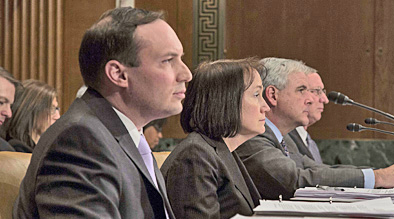Today, on the fourth anniversary of the Fukushima accident, the Nuclear Regulatory Commission (NRC) is on the verge of a major decision that could determine whether or not the types of regulatory errors that set the stage for the accident in Japan will be effectively fixed in the United States. The four sitting commissioners (one seat is empty) are currently voting on a controversial proposal by the agency’s senior management that, if accepted as written, could undermine nuclear safety for years to come.
The commissioners should reject the proposal.
The Vulnerability of U.S. Reactors to Earthquakes and Floods
The proposal before the NRC is an attempt to address a major vulnerability: Most U.S. nuclear plants are not adequately protected against the kinds of natural disasters that led to Fukushima, such as earthquakes and floods. Given that the NRC says it requires nuclear plants to be protected against the worst-case earthquakes or floods that may affect them (and then some), one may wonder why these vulnerabilities even exist.
The explanation is simple. At the time when the NRC (or its predecessor, the Atomic Energy Commission) originally licensed the nuclear plants operating today, in many cases the information at hand about seismic and flooding hazards at each site was just plain wrong, or the methodologies being used were inadequate. Compounding that problem is the very real possibility that extreme weather events are becoming more common as a result of climate change, further calling into question those deficient early assessments.
There is a straightforward solution to this problem: The NRC should require nuclear plants to upgrade their basic levels of protection (called the “design basis”) so that the plants could withstand the greater hazards they are now known to face.
The problem is that this solution would likely require significant additional expenditures by the nuclear industry, which is already in economic distress because of competition from cheap natural gas. And at some plants, the threat from flooding may be so severe that the most prudent action might be to shut them down rather than to encase them in watertight boxes.
As a result, the nuclear industry has been actively pushing for a cheaper alternative. Rather than requiring upgrades to the design basis of nuclear plants to prevent earthquakes and floods from damaging nuclear plant systems that could lead to a meltdown, it instead wants to mitigate the effects of the damage after it has occurred.
In particular, the industry has proposed that the NRC instead require upgrades to the portable equipment, known as FLEX, that is currently being installed at plants around the country to mitigate an extended loss of alternating current power—one of the precipitating factors that led to the core meltdowns at Fukushima Daiichi. (Fukushima Daiichi also lost most direct current power and most of its electrical distribution system.) This would be cheaper because, for one thing, the NRC has already decided that the FLEX equipment does not have to meet the tough standards (called “safety-related”) that is required for the structures, systems and components that protect the plant against design-basis accidents.
But ultimately, you get what you pay for—less robust equipment will be less dependable in an accident.
Also, by putting less emphasis on preventing equipment from being damaged in an earthquake or flood, the proposed shift would put more emphasis on trying to deal with the consequences of damaged equipment at the reactor. This requires the kind of heroic actions that the personnel at Fukushima were forced to carry out, ultimately with little success in preventing three meltdowns.
Dissent at the NRC
It is this cheaper “super-FLEX” alternative that has gained the support of most of the NRC’s bureaucrats and is at the heart of the pending proposal. But there is a revolt in the ranks. Two groups of NRC staff filed administrative objections, known as “non-concurrences,” to the proposal. One of the non-concurrences was signed by senior NRC managers: a very rare occurrence that illustrates the seriousness of the problem. Nevertheless, these concerns were ultimately dismissed by NRC upper management, who sent the proposal to the commissioners with few changes.
Fundamentally, if the commissioners vote for the proposal, they would establish a precedent that the design basis of the operating nuclear fleet does not have to be updated to address new or more accurate hazard information. This would enshrine in policy the notion that even if a plant were licensed to the wrong design basis, the NRC is not obligated to make it right.
Yesterday, Commissioner Kristine Svinicki revealed in a speech at the NRC Regulatory Information Conference that she had voted for the proposal, which is hardly a surprise for anyone familiar with her voting record on Fukushima-related matters.
But the votes of the other commissioners are not yet public. The NRC still has a chance to prove that it takes the lessons of Fukushima seriously by rejecting the proposal. Otherwise, dozens of U.S. plants will remain at an unacceptable level of risk from Fukushima-type disasters.
And if such an event happens here, unlike the Japanese we will not have the liberty to claim that it was “unexpected.”

